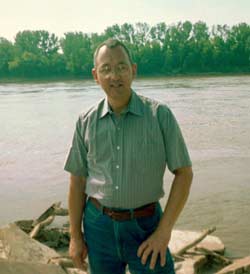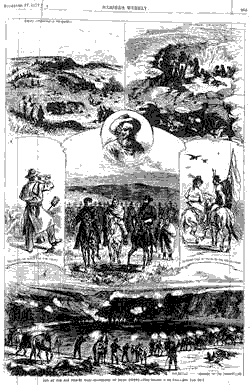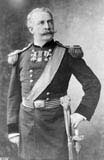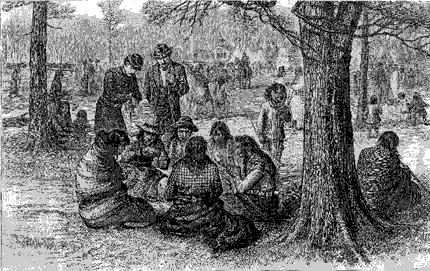

«Missouri River • Great Plains • Rocky Mountains» | «Radio • Ride • Resources»
Matt Nowak is the Forester and Natural Resources Director for the army at Fort Leavenworth, Kansas. The Fort houses an original National Cemetery (established by President Lincoln), the nation's first military prison, an officer's school, and the Fort harbors several huge boatloads of history. One June 2001 morning, on the banks of the Missouri, we talked with Matt about his efforts to bring Native tribes, particularly the Nez Perce, back to the fort -- under pleasanter circumstances than their previous visit.
Nowak is the Forester and Natural Resources Director for the army at Fort Leavenworth, Kansas. The Fort houses an original National Cemetery (established by President Lincoln), the nation's first military prison, an officer's school, and the Fort harbors several huge boatloads of history. One June 2001 morning, on the banks of the Missouri, we talked with Matt about his efforts to bring Native tribes, particularly the Nez Perce, back to the fort -- under pleasanter circumstances than their previous visit.
What connection does the Military have with the Nez Perce tribe.
We have a couple of really strong ties with Lewis & Clark here, especially since Fort Leavenworth is the only active-duty Army base on the entire trail from the Atlantic to the Pacific.
On the other side of this grove of trees that we call Chief Joseph Picnic Area you can actually walk through the main channel where Lewis & Clark pushed their boats up the river. As far as Nez Perce goes, why do we have Chief Joseph Picnic Area and Chief Joseph Loop and Nez Perce Way? The Nez Perce, their connection with Lewis & Clark, first of all, is that they helped them an awful lot, in both directions. The two of them enjoyed each other's company. We know they wrote in the journals that they raced horses, probably played card games, kind of games of chance. So theres a really strong tie between the military and the Nez Perce.
the other side of this grove of trees that we call Chief Joseph Picnic Area you can actually walk through the main channel where Lewis & Clark pushed their boats up the river. As far as Nez Perce goes, why do we have Chief Joseph Picnic Area and Chief Joseph Loop and Nez Perce Way? The Nez Perce, their connection with Lewis & Clark, first of all, is that they helped them an awful lot, in both directions. The two of them enjoyed each other's company. We know they wrote in the journals that they raced horses, probably played card games, kind of games of chance. So theres a really strong tie between the military and the Nez Perce.
Then in 1887 there was the Nez Perce War. I'm not going to go into the reasons for that. Really sad reasons as far as I'm concerned. But when the non-treaty Nez Perce -- there were five bands, the only two that survived the war were Joseph and Yellow Wolf, because the children were starving and freezing to death up in Montana, Joseph agreed to surrender to General Miles. Originally they were supposed to be taken back to their reservation in Idaho but the Army changed it's mind and instead brought them to Fort Leavenworth.
They arrived on train just right up here in the bluff area. From there, walked out across a road over here, across the bottom lands. And there was a horse race track out there, and they were incarcerated inside that horse race track.
We also know from the numbers that came in, there were 431 that came in on the train, and there was about 21 that didn't leave. And somewhere out there, probably in the vicinity of the race track, is where they were buried.
The
 media really picked up on Chief Joseph; he was a very eloquent speaker. They were a very proud people. They had a very good military history and so there were a lot of visitors that came from Kansas City and Leavenworth to see the Nez Perce. So many, in fact, that the army had to set up, in order to protect the Nez Perce from being bothered 24/7, they set a visiting hours for the people to come visit the Nez Perce.
media really picked up on Chief Joseph; he was a very eloquent speaker. They were a very proud people. They had a very good military history and so there were a lot of visitors that came from Kansas City and Leavenworth to see the Nez Perce. So many, in fact, that the army had to set up, in order to protect the Nez Perce from being bothered 24/7, they set a visiting hours for the people to come visit the Nez Perce.
It must have been quite a hullabaloo going, at that time Leavenworth had about 50,000 people. It was a far larger city than it is today. In fact, it was the largest city between St. Louis and San Francisco. This was the jumping off place for the west.
One of the things that the military tries to do is to maintain good relationships for all kinds of people. And we do, specifically, have a presidential directive to conduct government-to-government relations with Native American nations. One of my personal desires is to do a monument for the Nez Perce -- and for all the Native American tribes actually that were affected by Fort Leavenworth -- at the location where they probably would have gotten off the train, stood watching, right there by the airfield hangar area, looking out across where the tipis and the tents would have been set up.

![]() The Surrender of Joseph, Harper's Weekly, November 17, 1877
The Surrender of Joseph, Harper's Weekly, November 17, 1877
![]() "Fort Leavenworth and the Eclipse of Nationhood", Robert Kaplan Harper's Weekly, November 17, 1877
"Fort Leavenworth and the Eclipse of Nationhood", Robert Kaplan Harper's Weekly, November 17, 1877
![]() An Empire Wilderness, Chapter One: "Fort Leavenworth", Robert Kaplan
An Empire Wilderness, Chapter One: "Fort Leavenworth", Robert Kaplan
![]() Fort Leavenworth History
Fort Leavenworth History
![]() Fort Leavenworth Museum
Fort Leavenworth Museum
«Missouri River • Great Plains • Rocky Mountains» | «Radio • Ride • Resources»
©2001 Barrett Golding / Josef Verbanac
![]() Funding from the Corporation for Public Broadcasting
Funding from the Corporation for Public Broadcasting